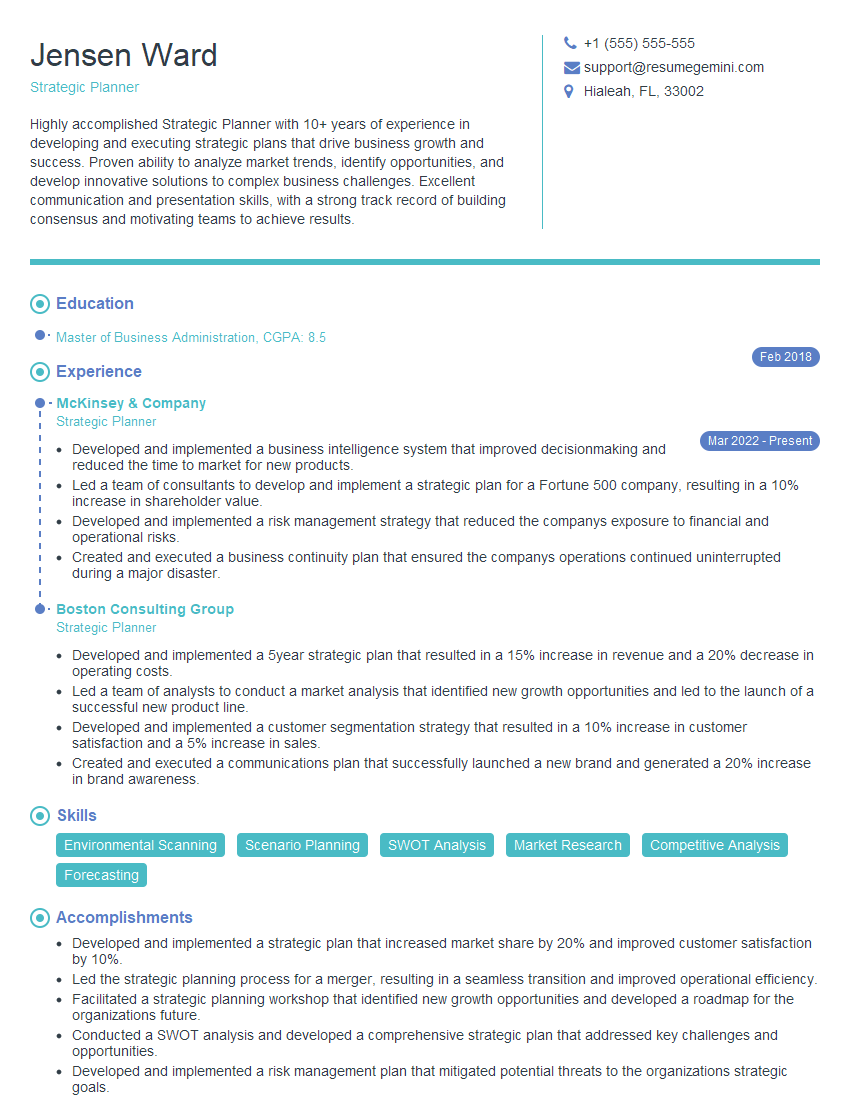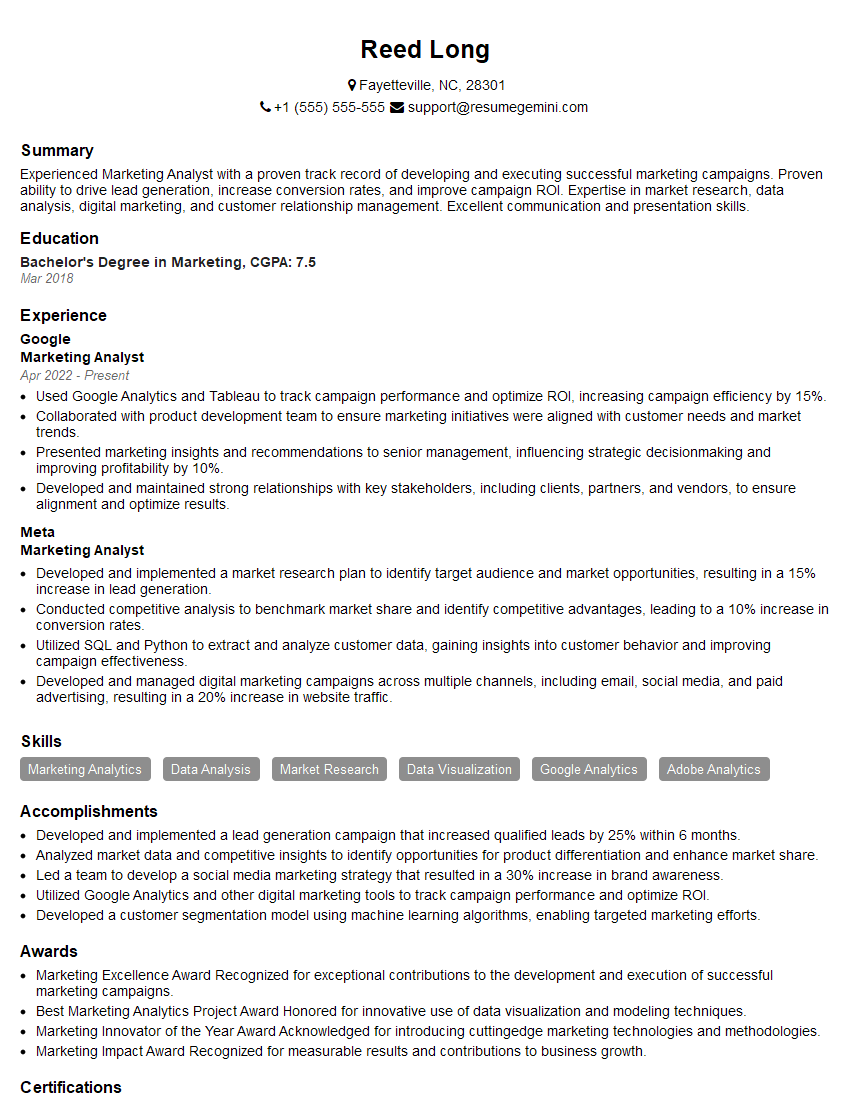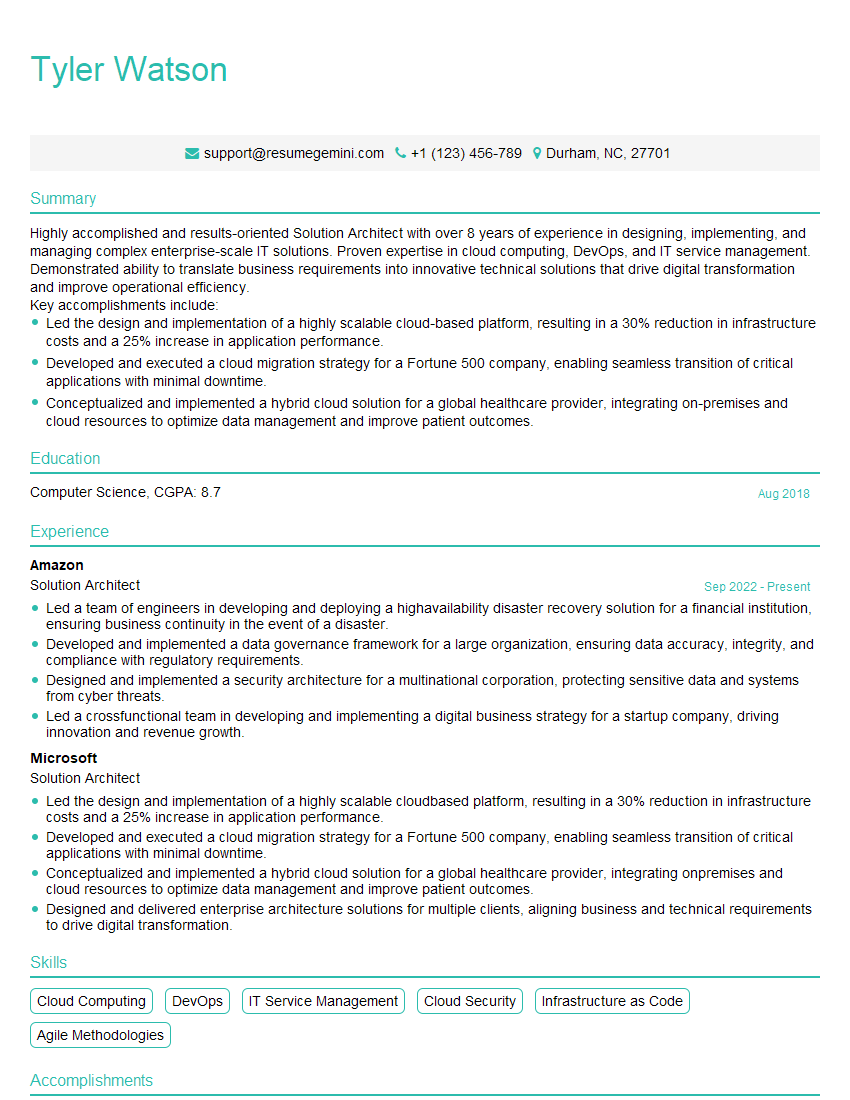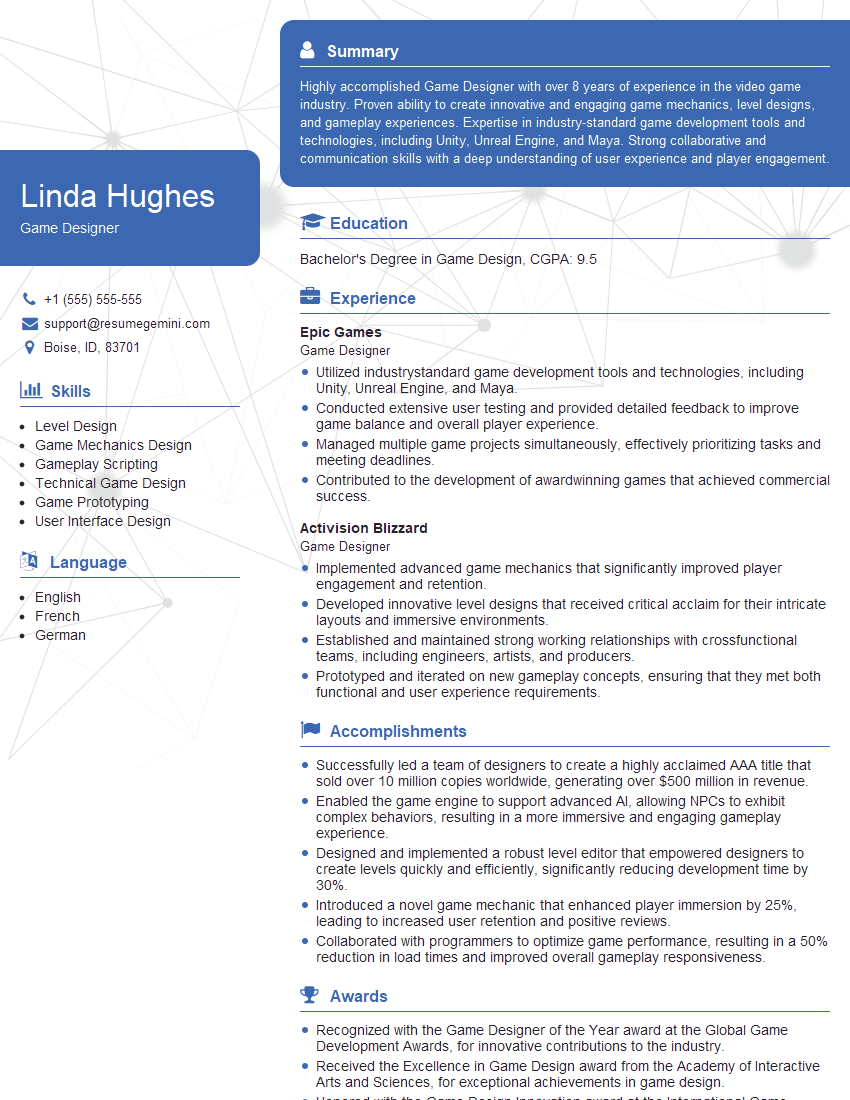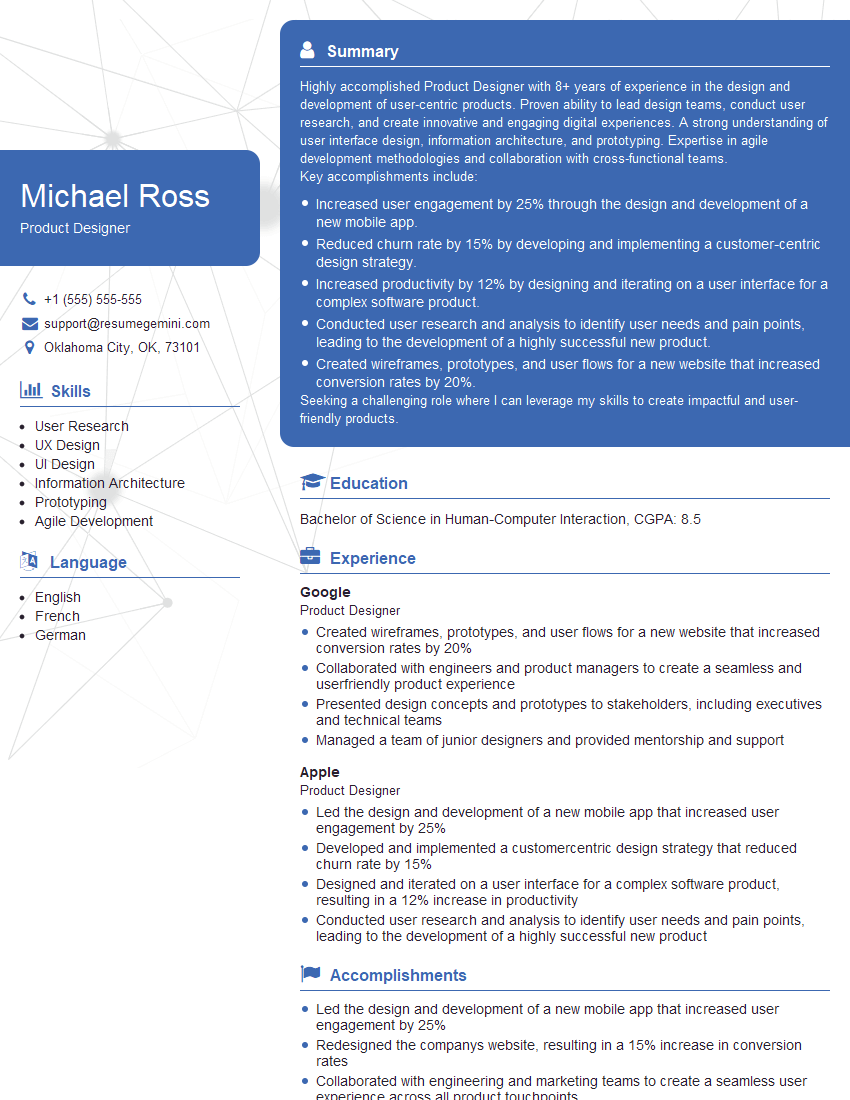Cracking a skill-specific interview, like one for Creative Problem-Solving and Adaptability, requires understanding the nuances of the role. In this blog, we present the questions you’re most likely to encounter, along with insights into how to answer them effectively. Let’s ensure you’re ready to make a strong impression.
Questions Asked in Creative Problem-Solving and Adaptability Interview
Q 1. Describe a time you had to adapt to a significant change in project requirements.
Adaptability is crucial in project management. A significant shift in project requirements necessitates a flexible approach. I remember working on a website redesign where, midway through development, the client decided to pivot from a primarily informational site to an e-commerce platform. This wasn’t just a cosmetic change; it involved a complete overhaul of the backend infrastructure, database design, and payment gateway integration.
My approach involved several steps: First, I held a meeting with the development team and the client to clearly understand the new requirements and scope. We documented all changes meticulously. Second, we prioritized the new features based on urgency and impact, using a MoSCoW method (Must have, Should have, Could have, Won’t have). Third, we re-evaluated the project timeline, adjusting sprints accordingly and setting new milestones. Fourth, we utilized agile methodologies to allow for flexibility and iterative development, allowing us to incorporate feedback throughout the process. The result was a successful launch of the e-commerce site, albeit with a revised timeline. This experience underscored the importance of clear communication, collaborative decision-making, and agile methodologies in responding to evolving project needs.
Q 2. How do you approach a problem when you don’t have all the necessary information?
When faced with incomplete information, I employ a structured approach. I start by identifying what information is missing and its potential impact on the problem. Then, I gather any available data, focusing on reliable sources and verifying their credibility. I might utilize brainstorming techniques, such as mind mapping, to explore potential solutions based on partial information, acknowledging the assumptions made due to the knowledge gaps. Next, I develop a plan that incorporates contingency measures to address potential issues arising from the lack of information. Finally, I prioritize tasks that can be completed with the available data, while simultaneously actively seeking out the missing information through research, discussions with stakeholders, and potentially pilot testing different approaches.
For instance, if I needed to design a marketing campaign with limited demographic data, I’d start by analyzing existing data on customer behavior. I’d then use market research tools to fill in the gaps, making informed assumptions about the target market until more concrete data becomes available. I’d also create a plan to track campaign performance and refine the strategy as I gain more insights.
Q 3. Explain your process for brainstorming creative solutions.
My brainstorming process is iterative and collaborative. I firmly believe that diverse perspectives lead to richer solutions. I typically begin with a clear definition of the problem, ensuring everyone understands the challenge. Then, I employ various techniques:
- Mind Mapping: Starting with the central problem, we branch out to explore related ideas and potential solutions.
- SCAMPER: This checklist prompts us to consider Substitute, Combine, Adapt, Modify, Put to other uses, Eliminate, and Reverse aspects of the problem or existing solutions.
- Lateral Thinking: Encouraging participants to challenge assumptions and consider unconventional approaches.
Throughout this process, we encourage free-flowing ideas, deferring judgment until a comprehensive list is generated. Once we have a diverse set of potential solutions, we analyze their feasibility, practicality, and potential impact, using criteria like cost, time, and risk assessment. The final step involves selecting the most promising solutions and refining them further.
Q 4. Describe a time you had to think outside the box to solve a problem.
In a previous role, we faced a significant challenge: improving customer engagement with our mobile app despite a limited budget. Traditional marketing strategies were proving too expensive. I proposed a solution that involved partnering with micro-influencers – individuals with smaller, but highly engaged, social media followings within our target demographic. This approach was outside the box because we were avoiding the large-scale advertising campaigns that had become the norm. We leveraged the authenticity and trust associated with micro-influencers to generate organic reach and positive word-of-mouth marketing. The results were remarkable: we saw a significant increase in app downloads and user engagement at a fraction of the cost of traditional methods. This success highlighted the power of unconventional thinking and leveraging resources efficiently.
Q 5. How do you prioritize tasks when faced with multiple competing deadlines?
Prioritizing tasks with competing deadlines involves a strategic approach. I use a combination of techniques including Eisenhower Matrix (urgent/important), Pareto Principle (80/20 rule), and critical path method. The Eisenhower Matrix helps classify tasks, focusing on urgent and important tasks first. The Pareto Principle helps focus efforts on the 20% of tasks yielding 80% of the results. The critical path method identifies tasks directly impacting the completion of the project. I also consider dependencies between tasks. I create a prioritized task list using a project management tool, visually representing the tasks and deadlines, and constantly update it based on progress and emerging priorities. Open communication with stakeholders is essential to manage expectations and ensure alignment on priorities. This structured approach minimizes stress and maximizes efficiency in achieving the most crucial goals.
Q 6. How do you handle pressure and stress in a fast-paced environment?
Fast-paced environments often bring pressure and stress. My approach emphasizes proactive strategies to maintain effectiveness:
- Time Management: Employing techniques like time blocking and Pomodoro to maximize focus and productivity.
- Prioritization: Utilizing the methods described above to focus on the most critical tasks first.
- Delegation: Effectively assigning tasks to team members based on their strengths.
- Mindfulness and Self-Care: Incorporating practices like regular breaks, exercise, and sufficient sleep to manage stress levels.
- Communication: Proactive communication with team members and stakeholders to ensure transparency and manage expectations.
By focusing on these strategies, I can navigate high-pressure situations while maintaining a healthy work-life balance. Recognizing my limitations and seeking support when needed is also crucial.
Q 7. Give an example of a time you failed to adapt and what you learned from it.
In one instance, I failed to adapt quickly enough to a change in technology. A project relied on a specific software platform which became obsolete. Instead of promptly embracing a new platform, I initially tried to maintain the old system, leading to significant delays and increased costs. The lesson learned was the importance of staying updated on technological advancements and being proactive in identifying and adopting suitable alternatives. This experience taught me the importance of continuous learning, evaluating new technologies regularly, and having contingency plans in place to mitigate the risks associated with rapid technological change. Now, I prioritize continuous professional development and maintain a broad awareness of emerging technologies within my field.
Q 8. Describe your preferred method for collaborating with others to solve complex problems.
My preferred method for collaborative problem-solving centers around a structured yet flexible approach. I believe in leveraging the strengths of diverse perspectives, which I achieve through a multi-phased process. It starts with clearly defining the problem and desired outcomes. Then, I facilitate brainstorming sessions using techniques like mind mapping or SCAMPER (Substitute, Combine, Adapt, Modify, Put to other uses, Eliminate, Reverse) to generate a wide range of ideas. This is followed by a critical evaluation phase where we analyze the feasibility, impact, and potential risks associated with each proposed solution. Finally, we collaboratively select the most promising solution, outlining clear roles and responsibilities for its implementation and monitoring.
For example, in a previous project involving optimizing a software development workflow, we utilized a combination of brainstorming and a SWOT (Strengths, Weaknesses, Opportunities, Threats) analysis. This enabled us to identify bottlenecks and develop a streamlined process that increased team productivity by 20%. Crucially, I ensure everyone feels heard and valued throughout this process, fostering a collaborative environment that encourages open communication and constructive feedback.
Q 9. How do you identify and overcome obstacles to achieving your goals?
Identifying and overcoming obstacles requires a proactive and adaptable mindset. I start by anticipating potential challenges during the planning phase using techniques like risk assessment matrices. When obstacles inevitably arise, I employ a systematic approach. First, I clearly define the nature of the obstacle. Next, I brainstorm potential solutions, considering both short-term workarounds and long-term solutions. I then evaluate the feasibility and impact of each solution, selecting the most effective one based on available resources and time constraints. Finally, I monitor the implemented solution and make necessary adjustments along the way. Regular progress reviews are vital to identify and address emerging issues promptly.
For instance, while leading a project that involved integrating a new software system, we encountered unexpected compatibility issues. Instead of panicking, we documented the problems, investigated the root causes, prioritized solutions based on their impact, and successfully implemented workarounds to ensure project completion while simultaneously working on a long-term fix.
Q 10. Explain your approach to risk management in a dynamic environment.
My approach to risk management in dynamic environments is iterative and data-driven. I don’t see risk as something to avoid but as an opportunity to learn and improve. My process involves three key steps: identification, assessment, and mitigation. First, I use brainstorming and checklists to identify potential risks. Second, I assess each risk’s likelihood and potential impact, prioritizing those with higher probability and severity. Finally, I develop mitigation strategies, including contingency plans, to address these high-priority risks. This entire process is continuously revisited and refined as the environment changes, making it highly adaptable to unexpected events.
Consider a marketing campaign launched during a period of economic uncertainty. We identified risks such as decreased consumer spending and increased competition. We mitigated these by creating multiple budget scenarios and developing a flexible campaign that could be quickly adapted to changing market conditions, allowing for real-time adjustments based on performance data.
Q 11. How do you assess the feasibility of a creative solution?
Assessing the feasibility of a creative solution requires a multi-faceted approach that goes beyond initial brainstorming. I assess feasibility across several key areas: technical, financial, operational, legal, and ethical. The technical feasibility considers whether the solution is technically achievable given existing resources and technology. The financial feasibility examines whether the solution is economically viable, considering costs and potential ROI. Operational feasibility assesses whether the solution can be implemented effectively within existing workflows and organizational structures. Legal and ethical considerations ensure compliance with relevant regulations and ethical standards. A thorough analysis across these dimensions provides a comprehensive understanding of the solution’s viability.
Imagine proposing a new AI-powered customer service chatbot. Technical feasibility would require assessing available AI technologies and integration capabilities. Financial feasibility would involve calculating development and maintenance costs and projecting return on investment. Operational feasibility would focus on integrating the chatbot into the existing customer service system and training employees. Finally, legal and ethical considerations would involve ensuring data privacy and compliance with relevant laws.
Q 12. Describe a time you had to make a quick decision under pressure.
During a product launch event, a critical software bug was discovered just minutes before the official unveiling. Instead of panicking, I immediately assembled a core team and assessed the severity and impact of the bug. We quickly determined that a temporary workaround was feasible, allowing us to proceed with the launch while simultaneously initiating a fix for the underlying issue. This required clear communication, decisive action, and the trust in my team’s abilities. The launch went ahead successfully, and the bug was fixed within hours, minimizing any negative impact on the event.
This experience highlighted the importance of remaining calm under pressure, delegating effectively, and focusing on finding practical solutions even with limited time.
Q 13. How do you handle disagreements or conflicting priorities among team members?
Handling disagreements and conflicting priorities requires skillful facilitation and communication. My approach focuses on understanding the root cause of the conflict, encouraging open dialogue, and finding common ground. I begin by actively listening to each team member’s perspective without judgment, aiming to understand their concerns and priorities. I then facilitate a structured discussion, encouraging everyone to express their ideas and concerns constructively. Next, I work collaboratively to find mutually acceptable compromises, prioritizing tasks based on impact and feasibility. Finally, I clearly communicate the agreed-upon decisions and ensure everyone understands their roles and responsibilities.
In one project, differing opinions arose regarding the design of a new website. By facilitating an open discussion, we identified the underlying reasons for the disagreement (personal preferences vs. user needs). Through collaborative design sessions and data analysis on user preferences, we reached a consensus that incorporated the best elements of each proposal, resulting in a more effective and user-friendly website.
Q 14. How do you measure the success of a creative solution?
Measuring the success of a creative solution depends on clearly defined goals and metrics set at the outset of the project. I use a combination of quantitative and qualitative methods. Quantitative metrics involve measuring tangible outcomes, such as sales figures, customer satisfaction scores, or efficiency improvements. Qualitative metrics assess less tangible aspects, such as team morale, customer feedback, or overall user experience. The specific metrics chosen will vary depending on the nature of the solution and the goals it seeks to achieve.
For example, when evaluating a new marketing campaign, I’d track quantitative metrics like website traffic, conversion rates, and sales revenue. In parallel, I’d gather qualitative feedback through customer surveys, social media monitoring, and focus groups to gauge customer satisfaction and perception. A comprehensive evaluation that considers both types of data provides a holistic picture of the solution’s success and offers valuable insights for future improvements.
Q 15. Describe a time you used data or analysis to inform a creative solution.
Data analysis is crucial for effective creative problem-solving. Instead of relying solely on intuition, I leverage data to identify patterns, understand user needs, and validate creative concepts. This data-driven approach helps mitigate risks and ensures solutions are grounded in reality.
For example, during a recent project aimed at improving user engagement on a social media platform, I analyzed user activity data. We discovered a significant drop-off in engagement after a specific feature update. This data pointed us towards a usability problem. Instead of guessing at the cause, we conducted A/B testing on different interface designs, using the previous data to inform our hypotheses. The results revealed that a simplified navigation structure significantly improved engagement, directly validating our analysis and leading to a successful solution.
Career Expert Tips:
- Ace those interviews! Prepare effectively by reviewing the Top 50 Most Common Interview Questions on ResumeGemini.
- Navigate your job search with confidence! Explore a wide range of Career Tips on ResumeGemini. Learn about common challenges and recommendations to overcome them.
- Craft the perfect resume! Master the Art of Resume Writing with ResumeGemini’s guide. Showcase your unique qualifications and achievements effectively.
- Don’t miss out on holiday savings! Build your dream resume with ResumeGemini’s ATS optimized templates.
Q 16. How do you stay up-to-date on industry trends and best practices?
Staying current in this rapidly evolving field requires a multi-pronged approach. I actively participate in online communities and forums dedicated to creative problem-solving and design thinking. This allows me to engage with peers, learn from their experiences, and participate in discussions about emerging trends.
I also subscribe to relevant industry publications and newsletters that focus on innovation and design. Furthermore, I regularly attend conferences and workshops to network with experts and learn about the latest tools and techniques. Finally, I dedicate time to researching academic journals and publications that contribute to the theoretical foundation of creative problem-solving and adaptability.
Q 17. How do you identify and leverage opportunities for innovation?
Identifying opportunities for innovation starts with a deep understanding of the current landscape. I employ a combination of techniques, including trend analysis, competitive analysis, and customer feedback analysis. Trend analysis involves researching emerging technologies, societal shifts, and market dynamics to identify unmet needs or potential disruptions. Competitive analysis requires studying competitors’ strengths and weaknesses to identify areas where innovation can create a competitive advantage.
Critically, actively soliciting and analyzing customer feedback is invaluable. This feedback offers direct insight into pain points and unmet needs that can fuel innovative solutions. For instance, by consistently observing user interactions and feedback on a product, we were able to identify a user frustration point that resulted in the development of a new feature that drastically improved user experience and satisfaction.
Q 18. How do you deal with ambiguity and uncertainty?
Ambiguity and uncertainty are inherent in creative work. My approach involves embracing these challenges as opportunities for exploration and learning. I start by clearly defining the problem, breaking it down into smaller, more manageable parts. Then, I develop multiple possible solutions, acknowledging the inherent unknowns. This involves using brainstorming techniques, scenario planning, and prototyping. Prototyping allows for testing different approaches and iterating based on feedback and evolving insights, enabling me to adapt effectively to changing conditions.
For example, when facing an ambiguous project brief, I would schedule meetings with stakeholders to clarify their expectations and gather comprehensive information. I would then create multiple preliminary designs or mockups, testing each to identify the best fit. This iterative approach, through several prototype iterations, helps navigate the uncertainty effectively.
Q 19. Describe your approach to continuous improvement.
Continuous improvement is a core principle for me. I regularly reflect on my work, identifying areas for enhancement. I utilize a structured approach, using methodologies like the PDCA cycle (Plan-Do-Check-Act). This cycle involves planning improvements, implementing them, evaluating the results, and making necessary adjustments. I also actively seek feedback from colleagues and supervisors to gain diverse perspectives on my performance and processes.
A practical example is my commitment to learning new software tools. After learning a new tool, I evaluate its impact on my workflow and identify areas where my proficiency could improve. I then dedicate time to practice and upskill, continually improving my efficiency and skillset.
Q 20. How do you handle criticism and feedback constructively?
Criticism and feedback are invaluable for growth. I view them as opportunities to learn and improve. I actively listen to the feedback, seeking to understand the perspective of the person providing it. I ask clarifying questions to ensure I fully grasp their concerns. Then, I reflect on the feedback, identifying aspects I can improve upon.
If the feedback is constructive, I use it to refine my work, making necessary changes. If the feedback seems subjective or unfair, I still consider its underlying concerns and reflect on how to potentially address them in future projects. This approach transforms criticism into an opportunity for self-improvement.
Q 21. Describe a time you had to learn a new skill quickly.
I once had to learn the basics of Python scripting within a week to automate data analysis for a time-sensitive project. My approach was multifaceted. I started by focusing on the specific tasks that needed automation, breaking them down into smaller, manageable steps. Then, I leveraged online resources, including tutorials and documentation, to understand the fundamental concepts and syntax of Python.
I practiced by tackling increasingly complex tasks, applying what I learned and constantly referencing online documentation. I also sought assistance from colleagues familiar with Python, asking for help when I encountered difficulties. This combination of targeted learning, practice, and peer support enabled me to quickly acquire the necessary skills and successfully complete the project.
Q 22. How do you motivate yourself and your team to overcome challenges?
Motivation is crucial for overcoming challenges, both individually and as a team. I approach this through a combination of strategies focusing on intrinsic and extrinsic motivation. Intrinsically, I foster a sense of purpose by clearly communicating the value and impact of our work. I emphasize the problem’s significance and how our solution will contribute to a larger goal. This helps create a sense of ownership and commitment. Extrinsically, I recognize and celebrate successes, both big and small, fostering a positive and encouraging environment. Regular feedback, both constructive criticism and praise, keeps everyone engaged and motivated. I also encourage open communication, creating a space where team members feel comfortable sharing their concerns and ideas, ensuring everyone feels heard and valued. For example, during a particularly challenging project involving a tight deadline, I organized team-building activities and offered flexible work arrangements to reduce stress and boost morale. This fostered a strong sense of camaraderie and helped us overcome the obstacles successfully.
Q 23. How do you use technology to enhance your creative problem-solving abilities?
Technology significantly amplifies my creative problem-solving abilities. I leverage tools such as mind-mapping software (like MindManager or XMind) to visually organize ideas and identify connections. These tools allow for brainstorming sessions to be easily documented and shared, fostering collaboration. I use collaborative platforms like Google Workspace or Microsoft Teams to facilitate real-time brainstorming and feedback. Moreover, data visualization tools (e.g., Tableau, Power BI) are essential for analyzing data and extracting insights, helping identify trends and patterns that inform creative solutions. Simulation software can allow for testing potential solutions in a controlled environment before implementation. For example, during a project requiring the optimization of a supply chain, I used simulation software to model different scenarios and identify the most efficient solution. Finally, I regularly explore and utilize emerging technologies like AI-powered tools for idea generation or design assistance to push boundaries and find unconventional approaches to complex problems.
Q 24. Describe a time you had to develop a novel approach to a familiar problem.
In a previous role, we faced a familiar problem: consistently long customer service call times. While standard solutions like increased staffing were considered, they were costly and lacked scalability. My novel approach involved analyzing call logs to identify common issues. We then developed a comprehensive knowledge base with readily available answers to frequently asked questions, accessible through a redesigned customer support website and an updated interactive voice response system (IVR). This diverted many simple inquiries away from agents, freeing them up to handle more complex issues. We also introduced a short training program for agents on proactive communication techniques to quickly identify and address customer needs. This multi-pronged approach resulted in a significant reduction in call times, a higher customer satisfaction rate, and a more efficient use of resources. This demonstrates my ability to re-imagine existing solutions by leveraging data-driven insights and combining them with improved communication strategies.
Q 25. How do you balance creativity with practicality in your problem-solving approach?
Balancing creativity and practicality is a crucial aspect of effective problem-solving. I approach this using a structured process. First, I encourage uninhibited brainstorming to generate a wide range of creative ideas, even those seemingly unrealistic. Then, I employ a rigorous evaluation process, analyzing each idea against key criteria such as feasibility, cost-effectiveness, and potential impact. This helps eliminate impractical options and prioritize those with a high likelihood of success. I use frameworks like SWOT analysis (Strengths, Weaknesses, Opportunities, Threats) to assess the viability of each solution, weighing its potential benefits against potential risks. For example, in designing a new marketing campaign, we initially generated numerous creative ideas, some involving costly, large-scale productions. After analyzing their feasibility and return on investment (ROI), we selected a campaign that balanced creativity with practicality, resulting in a successful marketing campaign that achieved its goals without exceeding the budget.
Q 26. Explain how you evaluate the potential impact of a creative solution.
Evaluating the potential impact of a creative solution requires a multi-faceted approach. I use quantitative methods, such as data analysis and forecasting, to project potential outcomes based on measurable metrics. For example, if designing a new product, I might conduct market research to assess demand and potential sales. Qualitative methods, such as surveys and interviews with target users, help gauge the perceived value and customer satisfaction associated with the solution. I also incorporate a risk assessment, identifying potential obstacles and their impact. A comprehensive cost-benefit analysis helps determine the financial viability of the solution, balancing potential returns against associated costs. Finally, I assess the solution’s alignment with overarching business goals and its potential for long-term sustainability. A holistic approach that integrates these quantitative and qualitative assessments ensures a thorough evaluation of the solution’s potential impact.
Q 27. How do you manage conflicting demands on your time and attention?
Managing conflicting demands requires effective time management and prioritization techniques. I employ time-blocking to schedule specific tasks and allocate sufficient time for each. I prioritize tasks based on urgency and importance, using methods like the Eisenhower Matrix (urgent/important). I leverage technology, like calendar apps and task management software (Asana, Trello, etc.), to track deadlines and ensure accountability. I also delegate tasks whenever possible, empowering team members and freeing up my time for more critical activities. Regularly reviewing my priorities and adjusting my schedule as needed helps me adapt to changing demands. Communicating proactively with stakeholders about my workload and potential delays helps prevent misunderstandings and maintains effective collaboration. This approach allows me to allocate my time strategically, maintaining focus and efficiency even amidst competing demands.
Q 28. Describe a time you had to effectively communicate a complex solution to a non-technical audience.
I once had to explain a complex data analytics solution to a board of directors, many of whom lacked a technical background. I avoided jargon and technical details, focusing on visual aids like charts and graphs to illustrate key findings. I used relatable analogies to simplify complex concepts. For example, I compared the data patterns to weather forecasting, illustrating how patterns helped predict future trends. I presented the solution’s impact in terms of business outcomes, emphasizing the improvements in efficiency, cost savings, and revenue generation. The presentation focused on the “so what?” – the practical implications and benefits for the business. I also prepared a concise summary document that reiterated the key takeaways and provided answers to anticipated questions. This approach allowed the board to grasp the solution’s essence and its value, fostering support and buy-in.
Key Topics to Learn for Creative Problem-Solving and Adaptability Interview
- Understanding the Problem: Defining the core issue clearly and concisely, identifying root causes, and gathering relevant information. Practical application: Analyzing a case study to pinpoint the central challenge and potential contributing factors.
- Brainstorming and Idea Generation: Employing diverse techniques like SCAMPER, lateral thinking, and mind mapping to generate a wide range of potential solutions. Practical application: Practicing brainstorming sessions to develop innovative solutions for hypothetical workplace scenarios.
- Evaluating and Selecting Solutions: Using criteria like feasibility, cost-effectiveness, and impact to assess the viability of different approaches. Practical application: Developing a scoring system to compare and contrast potential solutions objectively.
- Adaptability and Resilience: Demonstrating the ability to adjust plans in response to changing circumstances, learning from setbacks, and maintaining a positive attitude under pressure. Practical application: Reflecting on past experiences where you successfully adapted to unexpected challenges.
- Communication and Collaboration: Effectively communicating ideas, collaborating with diverse teams, and actively listening to different perspectives. Practical application: Preparing examples showcasing your ability to work effectively in collaborative problem-solving environments.
- Implementation and Follow-up: Developing action plans, monitoring progress, and making adjustments as needed to ensure successful implementation. Practical application: Outlining a step-by-step plan for implementing a solution and outlining potential contingency plans.
Next Steps
Mastering creative problem-solving and adaptability is crucial for career advancement. These skills are highly valued by employers across all industries, demonstrating your ability to navigate complex situations and contribute meaningfully to team success. To maximize your job prospects, focus on crafting a compelling, ATS-friendly resume that showcases these abilities. ResumeGemini is a trusted resource that can help you build a professional resume that highlights your strengths and makes a lasting impression. Examples of resumes tailored to showcase creative problem-solving and adaptability are available through ResumeGemini to further guide your preparation.
Explore more articles
Users Rating of Our Blogs
Share Your Experience
We value your feedback! Please rate our content and share your thoughts (optional).
What Readers Say About Our Blog
Hello,
We found issues with your domain’s email setup that may be sending your messages to spam or blocking them completely. InboxShield Mini shows you how to fix it in minutes — no tech skills required.
Scan your domain now for details: https://inboxshield-mini.com/
— Adam @ InboxShield Mini
Reply STOP to unsubscribe
Hi, are you owner of interviewgemini.com? What if I told you I could help you find extra time in your schedule, reconnect with leads you didn’t even realize you missed, and bring in more “I want to work with you” conversations, without increasing your ad spend or hiring a full-time employee?
All with a flexible, budget-friendly service that could easily pay for itself. Sounds good?
Would it be nice to jump on a quick 10-minute call so I can show you exactly how we make this work?
Best,
Hapei
Marketing Director
Hey, I know you’re the owner of interviewgemini.com. I’ll be quick.
Fundraising for your business is tough and time-consuming. We make it easier by guaranteeing two private investor meetings each month, for six months. No demos, no pitch events – just direct introductions to active investors matched to your startup.
If youR17;re raising, this could help you build real momentum. Want me to send more info?
Hi, I represent an SEO company that specialises in getting you AI citations and higher rankings on Google. I’d like to offer you a 100% free SEO audit for your website. Would you be interested?
Hi, I represent an SEO company that specialises in getting you AI citations and higher rankings on Google. I’d like to offer you a 100% free SEO audit for your website. Would you be interested?
good
